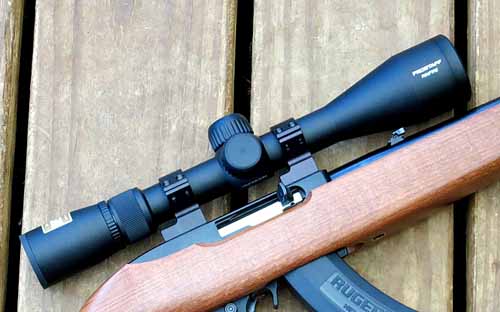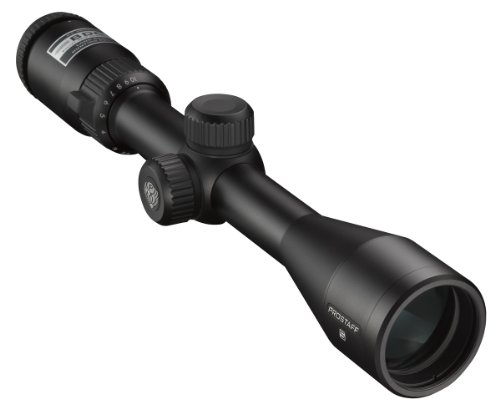We’ll be dissecting Nikon vs Vortex and giving you a little taste of both (2 representative scopes from each maker and a little comparing and contrasting to boot).
Vortex vs Nikon Scopes Rd 1: Nikon P-223
The Nikon P-223 is a cool little optic. It was designed for the AR enthusiast but could sit at home on any .223 caliber rifle. This compact optic has a short magnification, which ranges from 1.5-4.5 magnification. This makes it perfectly suitable for 223 and AR 15 platforms. On an AR the lower power is perfect for close range shooting and then when things get a little further away you can zoom in and make precise shots. The glass is great and does provide a clear picture, but side by side, the Strike Eagle from Vortex (see below) is going to be clearer.
The optic is equipped with a bullet drop compensating reticle that’s tuned to the .223 and 5.56 caliber projectiles. This BDC gives you an instant ballistic calculation for estimating bullet drop. Each dot represents a certain range and the shooter can simply use the appropriate dot for the appropriate range. The Nikon P-223 makes long range shooting nice and easy, but you’ll still need to master the fundamentals to make it work. The downside to this BDC is that it’s tuned to one round and one round only.
The scope will ease you into hitting targets at extended ranges and allow you to focus on those shooting fundamentals instead of worrying about your range and elevation. The main advantage the Nikon has is its ease of use for AR owners, and .223 rifle owners in general. It’s so simple and easy to use.
The Nikon P-223 uses spring-loaded instant zero-reset turrets. This allows you to zero the optic and return the turrets to zero. Then, when it in the field you can make corrections for wind or elevation. At the end of the day, you dial back to one and you are on your normal zero. The Nikon P-223 is Nikon’s best entry into the AR 15 world of optics. Plus the price is a great deal, and the savings equals more ammo and more range time.
Vortex vs Nikon Scopes Rd 2: Vortex Strike Eagle
Vortex’s entry into the world of AR optics is the Strike Eagle. The Strike Eagle is generally a more expensive optic than the Nikon, but the cost is justified in a few different ways. First, this is a 1 to 6 power optic. So it’s a little more powerful. It offers the same close-range advantages and long-range potential as the Nikon with just a little extra to it. The Strike Eagle is also slightly bigger with a 24 mm objective lens. It’s a little meatier, but the weight difference isn’t too significant.
Like most Vortex optics, the glass is surprisingly brilliant (see full specs) in the definition. At this price range, it’s certainly a top contender for clarity. When the sun gets low, this scope’s going to give more performance over the Nikon. The Strike Eagle reticle is also well designed for close quarter’s use and long range precision. It uses three-quarters of a circle that acts almost like a red dot at close range. Under that, you have several different hash marks that are used like a BDC, although these are not dialed into one specific round like the Nikon.
This is actually can be an advantage. ARs come in every caliber imaginable and this allows you to experiment with .300 Blackout, 7.62×39, 224 Valkyrie, 6.5mm Grendel, and many more. You’ll just need to be willing to learn the correct holdovers for these rounds.
That’s where these scopes differ greatly. The Strike Eagle is aimed more at the experienced shooter. The shooter who understands range and elevation, as well as bullet drop. The Strike Eagle will provide you a clearer picture and an overall more refined scope. It expects you to do your work though.
You’ll have to learn your dope the old school way. Go out and shoot on your chosen rifle with your chosen round. The Strike Eagle is made tough too. It’s a single piece of aluminum and is water, shock, and fogproof. Vortex knows what their doing and this one has a slight edge in quality, but quality comes at a cost.
Making the decision here is tough. You need to honestly evaluate your skills and decide what level of shooting experience you have. If you are new to extended range shooting I’d suggest the Nikon. If you have some range time under your belt you may be better served with the Strike Eagle
Vortex vs Nikon Scopes Rd 3: Nikon Prostaff 5
The Nikon ProStaff 5 is Nikon’s latest and greatest in the Pro Staff line and one of your humble author’s favorite optics. It’s rugged, reliable, and engineered to ooze precision performance. There are several models, but I found the 2.5-10x to be the most versatile. The 2.5 power is perfect for brush hunting and close range shooting and the 10 power allows me to stretch my legs when necessary, or to hit really small targets at close range. I find the ProStaff to have the more useful range ration.
The Prostaff 5 (see full specs) uses Nikon’s BDC reticle which features unique see-through dots as hold markers. This means you never obscure your target. The reticle is very clean and doesn’t hog most of your vision. This does give a slight edge to long-range shooting to the ProStaff over the Vortex. These clear drop dots make seeing targets at long distances possible.
The Prostaff 5’s quick focus eyepiece works like a dream for fast shooting, and along with the 2.5 setting is a brush hunters best friend. Dialed out to 10x easily allows you to see and shoot distant targets.
The Nikon glass in these optics is top notch and the lenses are fully multi-coated for maximum brightness and light transmission. This is perfect for those low light situations where you need to take precise long-range shots. The downside is going to be the price. It’s generally a more expensive optic, but it’s ultimately the higher quality option and the slightly more modern option.
Vortex vs Nikon Scopes Rd 4: Vortex Crossfire 2
The Vortex Crossfire 2 is in the reverse situation the Strike Eagle found itself in. It’s generally the cheaper of the two optics, and while a great optic it’s a little lower on the bar than the ProStaff 5. It’s still a great optic, though.
The Crossfire 2 packs a 4-12 power magnification level, with a 44m objective lens. The Crossfire 2 gives you a choice between the Bead Hold BDC or the V Plex reticles. I prefer the Dead Hold personally, but opinions differ. The Dead-Hold BDC uses your traditional hash marks, which may obscure some long range targets.
The 12 power magnification rating is higher than the ProStaff, but you have to ask yourself how much that exactly matters. A little more magnification can be great, but the higher 4 power magnification is less useful for short range shots.
The Crossfire 2 is coated with anti-reflective and fully multi-coated lenses that provide the shooter with a bright and crystal clear picture. No one doubts the low light performance of this optic.
At this price, it really is second to none. Vortex is run by sportsman and they know what’s needed for those early evening and sunrise shots. In low light shooting and observing both scopes, I found the Pro Staff and Crossfire to be matched evenly. Both deliver great low light sight pictures. The Crossfire 2 allows easy shots at long range and the 4 power setting covers the under 100 yards ranges pretty well.
The Crossfire 2 is at home on a hunting rifle or even budget long range setup. Its single-piece tube guarantees rugged durability and gives shooters the most precision possible. The tube is O ring sealed and nitrogen purged for fog proof performance. As the final kicker, the turrets are finger adjustable, a nice feature to find on such an affordable optic.
The Crossfire 2 is almost best described as a budget version of the ProStaff 5. They are very similar, but the Pro Staff 5 edges out the competition slightly but at a price.
Vortex vs Nikon Scopes – Which One?
As you can see both companies produce fantastic optics and offer plenty of options for different shooters. You won’t go wrong with either brand. Examine your needs, your budget, and then take the dive. These companies complement each other well, and the competition they create is giving us some outstanding optics. Good luck!











Great article!I was in the same conundrum when I finally tried to purchase a new scope and for the longest I was dead set on mounting the prosatff 4×12 with bdc I tried looking through the vortex diamondback ,but idid not like the lack of eye relief and then a sales man showed my the newer diamondback yo 4×16 with bdc ,it cost more but was better glass ,at the same time the Nikon was no slouch and it was about 200$less than the vortex